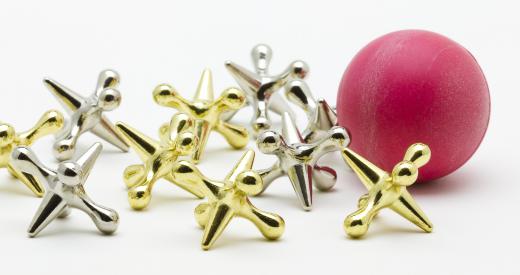Knucklebones is an ancient game that was originally played with the bones of the joints from animals such as sheep. The game had a number of variations, and it appears to have arisen in different parts of the world, demonstrating that humans can be extremely innovative, even with minimal supplies. It is still played today, although the gaming pieces are not typically made from bone; a closely related game is jacks, which is traditionally played with metal pieces and a small rubber ball. Some gaming stores stock sets for playing, along with instructions for an assortment of variations on the game.
The game relies on the distinct character of joint bones. Joints are knobbly, rather than smooth, and they have distinctly identifiable sides. When tossed, the bones tend to land on one of four sides, avoiding the curved ends. Essentially, this game could be viewed as an early version of dice, with four possible point values rather than six.

To play, people toss the bones on the ground and record their point value. The Romans had a complex scoring system for the game, with the highest score going to a “Venus,” a throw in which four bones were thrown and four different sides were displayed. Other scores were calculated on the basis of the point value of the sides; depending on the situation, the game might be played until someone threw a Venus or until a certain score was reached.

Knucklebones could also be played much like jacks, with one bone being tossed and caught in or on the hand, or the player performing a variety of tricks like trying to pick up all the bones on the ground while one was in the air. Some games involved repeating tricks displayed by another player, such as tossing three bones in the air and catching them all on the back of the hand. The process of tossing and catching would have have the added bonus of helping children to develop good hand-eye coordination, a highly useful skill.

In addition to being played with pieces of literal bone, knucklebones can also be played with gaming pieces made from clay, metal, or horn. The Romans made pieces encrusted with precious stones or engraved with various symbols, much like dice, which appear to be Asian in origin. They knew the game as tali or tala. Other aliases for it include dibs, jackstones, five stones, dibstones, and chuckstones.
